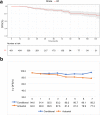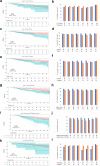Dynamic survival analysis of gastrointestinal stromal tumors (GISTs): a 10-year follow-up based on conditional survival
- PMID: 34724907
- PMCID: PMC8559392
- DOI: 10.1186/s12885-021-08828-y
Dynamic survival analysis of gastrointestinal stromal tumors (GISTs): a 10-year follow-up based on conditional survival
Abstract
Background: The prognosis of patients with gastrointestinal stromal tumors (GISTs) is generally evaluated at the time of diagnosis but does not reflect the survival dynamics of patients in the future. Therefore, the purpose of this article was to evaluate the conditional survival (CS) of Chinese patients with GISTs after radical resection.
Methods: This retrospective study included 451 patients who underwent radical surgery for GISTs. A Cox proportional hazard model was used to evaluate the prognostic factors of disease-free survival (DFS). The 3-year conditional DFS (CDFS3) of patients who survived for x years was expressed as CDFS3=DFS(x + 3)/DFS(x).
Results: The traditional 3-year DFS rate decreased gradually from 94.0% at 3 years to 77.3% at 7 years, while the CDFS3 rate increased from 94.0 to 95.2% over the survival time of the patients. In addition, classic clinicopathological prognostic factors had different effects on CDFS3, with changes observed in survival time, but these effects were only slight or moderate (|d|<0.5). Although multivariate analysis showed that age, sex, mitotic index and tumor rupture were independent risk factors for DFS at baseline, all adverse prognostic factors, except for the mitotic index, lost their predictive significance at 5 years after operation. When the Modified NIH criteria were included, the risk staging was found to be an independent risk factor for recurrence or death. Time-dependent Cox regression analysis showed that the modified NIH criteria independently affected the recurrence or death of GIST patients within 2 years after operation.
Conclusion: CS provides detailed dynamic survival information about Chinese patients with primary resected GISTs. The mitotic index is of great clinical significance for the monitoring and follow-up of patient populations with a high risk of tumor recurrence or death until 5 years after surgery.
Keywords: Chinese patients; Conditional survival; Gastrointestinal stromal tumors; Prognosis; Surgery.
© 2021. The Author(s).
Conflict of interest statement
No conflict of interest has been declared by the authors.
Figures


References
-
- Ducimetière F, Lurkin A, Ranchère-Vince D, Decouvelaere A-V, Péoc'h M, Istier L, Chalabreysse P, Muller C, Alberti L, Bringuier P-P, et al. Incidence of sarcoma histotypes and molecular subtypes in a prospective epidemiological study with central pathology review and molecular testing. PLoS One. 2011;6(8):e20294. doi: 10.1371/journal.pone.0020294. - DOI - PMC - PubMed
-
- Nilsson B, Bümming P, Meis-Kindblom JM, Odén A, Dortok A, Gustavsson B, Sablinska K, Kindblom LG. Gastrointestinal stromal tumors: the incidence, prevalence, clinical course, and prognostication in the preimatinib mesylate era--a population-based study in western Sweden. Cancer. 2005;103(4):821–829. doi: 10.1002/cncr.20862. - DOI - PubMed
-
- DeMatteo RP, Ballman KV, Antonescu CR, Corless C, Kolesnikova V, von Mehren M, McCarter MD, Norton J, Maki RG, Pisters PWT, et al. Long-term results of adjuvant imatinib mesylate in localized, high-risk, primary gastrointestinal stromal tumor: ACOSOG Z9000 (Alliance) intergroup phase 2 trial. Ann Surg. 2013;258(3):422–429. doi: 10.1097/SLA.0b013e3182a15eb7. - DOI - PMC - PubMed
MeSH terms
LinkOut - more resources
Full Text Sources

